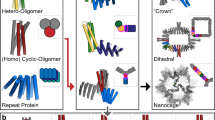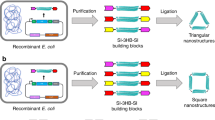Abstract
Supramolecular assembly is a powerful strategy used by nature to build nanoscale architectures with predefined sizes and shapes. With synthetic systems, however, numerous challenges remain to be solved before precise control over the synthesis, folding and assembly of rationally designed three-dimensional nano-objects made of RNA can be achieved. Here, using the transfer RNA molecule as a structural building block, we report the design, efficient synthesis and structural characterization of stable, modular three-dimensional particles adopting the polyhedral geometry of a non-uniform square antiprism. The spatial control within the final architecture allows the precise positioning and encapsulation of proteins. This work demonstrates that a remarkable degree of structural control can be achieved with RNA structural motifs for the construction of thermostable three-dimensional nano-architectures that do not rely on helix bundles or tensegrity. RNA three-dimensional particles could potentially be used as carriers or scaffolds in nanomedicine and synthetic biology.
This is a preview of subscription content, access via your institution
Access options
Subscribe to this journal
Receive 12 print issues and online access
$259.00 per year
only $21.58 per issue
Buy this article
- Purchase on Springer Link
- Instant access to full article PDF
Prices may be subject to local taxes which are calculated during checkout





Similar content being viewed by others
Change history
26 July 2010
In Fig. 5f of the version of this Article originally published online, the data for chain lengths of 4 and 5 were presented incorrectly. This error has now been corrected for all versions of the Article.
References
Gesteland, R. F., Cech, T. R. & Atkins, J. F. The RNA World, Third Edition (Cold Spring Harbor Laboratory Press, 2005).
Leontis, N. B., Lescoute, A. & Westhof, E. The building blocks and motifs of RNA architecture. Curr. Opin. Struct. Biol. 16, 279–287 (2006).
Holbrook, S. R. Structural principles from large RNAs. Annu. Rev. Biophys. 37, 445–464 (2008).
Jaeger, L., Verzemnieks, E. J. & Geary, C. The UA_handle: a versatile submotif in stable RNA architectures. Nucleic Acids Res. 37, 215–230 (2009).
Guo, P. RNA nanotechnology: engineering, assembly and applications in detection, gene delivery and therapy. J. Nanosci. Nanotechnol. 5, 1964–1982 (2005).
Jaeger, L. & Chworos, A. The architectonics of programmable RNA and DNA nanostructures. Curr. Opin. Struct. Biol. 16, 531–543 (2006).
Severcan, I. et al. Computational and experimental RNA nanoparticle design, in Automation in Genomics and Proteomics: An Engineering Case Based Approach (eds Alterovitz, G., Ramoni, M. & Benson, R. M.) 193–220 (Wiley, 2009).
Jaeger, L. & Leontis, N. B. Tecto-RNA: one-dimensional self-assembly through tertiary interactions. Angew. Chem. Int. Ed. 14, 2521–2524 (2000).
Jaeger, L., Westhof, E. & Leontis, N. B. TectoRNA: modular assembly units for the construction of RNA nano-objects. Nucleic Acids Res. 29, 455–463 (2001).
Shu, D., Huang, L. P., Hoeprich, S. & Guo, P. Construction of phi29 DNA-packaging RNA monomers, dimers and trimers with variable sizes and shapes as potential parts for nanodevices. J. Nanosci. Nanotechnol. 3, 295–302 (2003).
Horiya, S. et al. RNA LEGO: magnesium-dependent formation of specific RNA assemblies through kissing interactions. Chem. Biol. 10, 645–654 (2003).
Chworos, A. et al. Building programmable jigsaw puzzles with RNA. Science 306, 2068–2072 (2004).
Khaled, A., Guo, S., Li, F. & Guo, P. Controllable self-assembly of nanoparticles for specific delivery of multiple therapeutic molecules to cancer cells using RNA nanotechnology. Nano Lett. 5, 1797–1808 (2005).
Severcan, I., Geary, C., Verzemnieks, E., Chworos, A. & Jaeger, L. Square-shaped RNA particles from different RNA folds. Nano Lett. 9, 1270–1277 (2009).
Shu, D., Moll, W. D., Deng, Z., Mao, C. & Guo, P. Bottom-up assembly of RNA arrays and superstructures as potential parts in nanotechnology. Nano Lett. 4, 1717–1723 (2004).
Koyfman, A. Y. et al. Controlled spacing of cationic gold nanoparticles by nanocrown RNA. J. Am. Chem. Soc. 127, 11886–11887 (2005).
Nasalean, L., Baudrey, S., Leontis, N. B. & Jaeger, L. Controlling RNA self-assembly to form filaments. Nucleic Acids Res. 34, 1381–1392 (2006).
Guo, S., Tschammer, N., Mohammed, S. & Guo, P. Specific delivery of therapeutic RNAs to cancer cells via the dimerization mechanism of phi29 motor pRNA. Hum. Gene. Ther. 16, 1097–1109 (2005).
Li, L. et al. Evaluation of specific delivery of chimeric phi29 pRNA/siRNA nanoparticles to multiple tumor cells. Mol. Biosyst. 5, 1361–1368 (2009).
Biou, V., Yaremchuk, A., Tukalo, M. & Cusack, S. The 2.9 A crystal structure of T. thermophilus seryl-tRNA synthetase complexed with tRNA(Ser). Science 263, 1404–1410 (1994).
Perona, J. J. & Hou, Y. M. Indirect readout of tRNA for aminoacylation. Biochemistry 46, 10419–10432 (2007).
Hansma, H. G., Oroudjev, E., Baudrey, S. & Jaeger, L. TectoRNA and ‘kissing-loop’ RNA: atomic force microscopy of self-assembling RNA structures. J. Microsc. 212, 273–279 (2003).
Shih, W. M., Quispe, J. D. & Joyce, G. F. A 1.7-kilobase single-stranded DNA that folds into a nanoscale octahedron. Nature 427, 618–621 (2004).
He, Y. et al. Hierarchical self-assembly of DNA into symmetric supramolecular polyhedra. Nature 452, 198–201 (2008).
Kato, T., Goodman, R. P., Erben, C. M., Turberfield, A. J. & Namba, K. High-resolution structural analysis of a DNA nanostructure by cryoEM. Nano Lett. 9, 2747–2750 (2009).
Ludtke, S. J., Baldwin, P. R. & Chiu, W. EMAN: semiautomated software for high-resolution single-particle reconstructions. J. Struct. Biol. 128, 82–97 (1999).
Weber, P. C., Ohlendorf, D. H., Wendoloski, J. J. & Salemme, F. R. Structural origins of high-affinity biotin binding to streptavidin. Science 243, 85–88 (1989).
Le Trong, I., Aubert, D. G., Thomas, N. R. & Stenkamp, R. E. The high-resolution structure of (+)-epi-biotin bound to streptavidin. Acta Crystallogr. D 62, 576–581 (2006).
Seeman, N. C. DNA enables nanoscale control of the structure of matter. Q. Rev. Biophys. 38, 363–371 (2006).
Seeman, N. C. An overview of structural DNA nanotechnology. Mol. Biotechnol. 37, 246–257 (2007).
Aldaye, F. A. & Sleiman, H. F. Modular access to structurally switchable 3D discrete DNA assemblies. J. Am. Chem. Soc. 129, 13376–13377 (2007).
Liu, D., Wang, M., Deng, Z., Walulu, R. & Mao, C. Tensegrity: construction of rigid DNA triangles with flexible four-arm DNA junctions. J. Am. Chem. Soc. 126, 2324–2325 (2004).
Goodman, R. P. et al. Rapid chiral assembly of rigid DNA building blocks for molecular nanofabrication. Science 310, 1661–1665 (2005).
Zheng, J. et al. From molecular to macroscopic via the rational design of a self-assembled 3D DNA crystal. Nature 461, 74–77 (2009).
Dietz, H., Douglas, S. M. & Shih, W. M. Folding DNA into twisted and curved nanoscale shapes. Science 325, 725–730 (2009).
Mathieu, F. et al. Six-helix bundles designed from DNA. Nano Lett. 5, 661–665 (2005).
Rothemund, P. W. Folding DNA to create nanoscale shapes and patterns. Nature 440, 297–302 (2006).
Wang, R., Liu, W. & Seeman, N. C. Prototyping nanorod control: a DNA double helix sheathed within a DNA six-helix bundle. Chem. Biol. 16, 862–867 (2009).
Douglas, S. M. et al. Self-assembly of DNA into nanoscale three-dimensional shapes. Nature 459, 414–418 (2009).
Andersen, E. S. et al. Self-assembly of a nanoscale DNA box with a controllable lid. Nature 459, 73–76 (2009).
Ke, Y. et al. Scaffolded DNA origami of a DNA tetrahedron molecular container. Nano Lett. 9, 2445–2447 (2009).
Kuzuya, A. & Komiyama, M. Design and construction of a box-shaped 3D-DNA origami. Chem. Commun. 4182–4184 (2009).
Saito, H. & Inoue, T. RNA and RNP as new molecular parts in synthetic biology. J. Biotechnol. 132, 1–7 (2007).
Saito, H. & Inoue, T. Synthetic biology with RNA motifs. Int. J. Biochem. Cell Biol. 41, 398–404 (2009).
Zuker, M. Mfold web server for nucleic acid folding and hybridization prediction. Nucleic Acids Res. 31, 3406–3415 (2003).
Liu, B., Baudrey, S., Jaeger, L. & Bazan, G. C. Characterization of tectoRNA assembly with cationic conjugated polymers. J. Am. Chem. Soc. 126, 4076–4077 (2004).
Suloway, C. et al. Automated molecular microscopy: the new Leginon system. J. Struct. Biol. 151, 41–60 (2005).
Lander, G. C. et al. Appion: an integrated, database-driven pipeline to facilitate EM image processing. J. Struct. Biol. 166, 95–102 (2009).
Acknowledgements
L.J. wishes to dedicate this paper to St. Luke and St. Marguerite Bourgeoys. Research funding to L.J. was provided by the National Institutes of Health (R01 GM079604). Cryo-EM experiments were conducted at the National Resource for Automated Molecular Microscopy, which is supported by the National Institutes of Health though the ‘National Center for Research Resources’ P41 program (RR17573). The authors thank H. Hansma for the generous use of her AFM and laboratory facilities. We also thank C. Potter and B. Carragher for their scientific input regarding cryo-EM and reconstruction.
Author information
Authors and Affiliations
Contributions
I.S. and C.G. contributed equally to this work. I.S., C.G. and L.J. conceived and designed experiments. I.S., C.G. and L.J analysed data. C.G. and L.J. designed the RNA particle and three-dimensional model. I.S. performed PAGE experiments. A.C. performed AFM characterization. N.V. and E.J. performed the cryo-EM characterization and reconstruction. L.J., C.G. and I.S. co-wrote the paper. All authors discussed the results and commented on the manuscript.
Corresponding author
Ethics declarations
Competing interests
The authors declare no competing financial interests.
Supplementary information
Supplementary information
Supplementary information (PDF 2262 kb)
Rights and permissions
About this article
Cite this article
Severcan, I., Geary, C., Chworos, A. et al. A polyhedron made of tRNAs. Nature Chem 2, 772–779 (2010). https://doi.org/10.1038/nchem.733
Received:
Accepted:
Published:
Issue Date:
DOI: https://doi.org/10.1038/nchem.733
This article is cited by
-
Structure, folding and flexibility of co-transcriptional RNA origami
Nature Nanotechnology (2023)
-
Multi-arm RNA junctions encoding molecular logic unconstrained by input sequence for versatile cell-free diagnostics
Nature Biomedical Engineering (2022)
-
Branched kissing loops for the construction of diverse RNA homooligomeric nanostructures
Nature Chemistry (2020)
-
Isothermal folding of a light-up bio-orthogonal RNA origami nanoribbon
Scientific Reports (2018)
-
Protein-driven RNA nanostructured devices that function in vitro and control mammalian cell fate
Nature Communications (2017)



